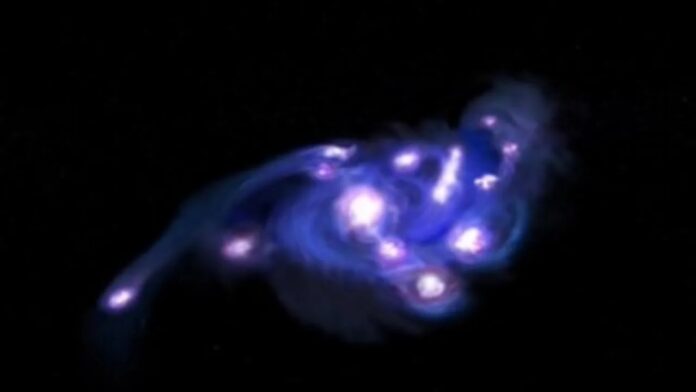"Discovering the Cosmic Grapes: A Stunning Glimpse into the Early Universe’s Star-Forming Clusters!"
Astronomers Discover "Cosmic Grapes": A Distant Galaxy with Unprecedented Star-Forming Clumps
In a groundbreaking study, astronomers have unveiled a distant galaxy, affectionately dubbed "Cosmic Grapes," which exhibits an astonishing arrangement of more than a dozen tightly packed star-forming clumps. This discovery, made using advanced observational techniques, challenges previous assumptions about the structure of early galaxies in the universe.
A Glimpse into the Early Universe
The Cosmic Grapes galaxy is believed to have formed approximately 930 million years after the Big Bang, a period when the universe was still in its infancy. Researchers utilized the powerful capabilities of NASA’s James Webb Space Telescope (JWST) and the Atacama Large Millimeter/submillimeter Array (ALMA) to investigate this celestial body. The galaxy was identified through a phenomenon known as gravitational lensing, where a foreground galaxy, RXCJ0600-2007, acts as a natural magnifying glass, allowing astronomers to observe more distant objects in greater detail.
Seiji Fujimoto, the lead author of the study and a researcher at the University of Toronto, noted, "This object is known as one of the most strongly gravitationally lensed distant galaxies ever discovered." The unique magnification provided by gravitational lensing, combined with the advanced observational capabilities of JWST and ALMA, enabled the team to examine the internal structure of the Cosmic Grapes galaxy with unprecedented sensitivity and resolution.
Detailed Observations
The research team dedicated over 100 hours to telescope observations, revealing that the Cosmic Grapes galaxy is not merely a smooth, rotating disk, as previously suggested by earlier Hubble Space Telescope images. Instead, the high-resolution data from JWST and ALMA unveiled a complex structure characterized by at least 15 massive star-forming clumps, which resemble a bunch of bright purple grapes in space.
Mike Boylan-Kolchin, a co-author of the study and an astronomy professor at UT Austin, emphasized the significance of these findings: "Our observations reveal that some early galaxies’ young starlight is dominated by several massive, dense, compact clumps rather than one smooth distribution of stars." This revelation reshapes our understanding of early galaxy formation, suggesting that many galaxies previously thought to be uniform may actually contain hidden clumps of star formation.
Implications for Galaxy Formation
The discovery of the Cosmic Grapes galaxy provides crucial insights into the processes that govern galaxy growth in the early universe. The clear connection between the galaxy’s internal structures—specifically, its massive star-forming clumps—and its overall rotation hints at a more complex formation history than previously understood. This challenges the notion that early galaxies were primarily smooth and homogeneous.
The findings were published on August 7 in the journal Nature Astronomy, marking a significant milestone in the study of cosmic evolution. The research not only enhances our understanding of the early universe but also opens new avenues for exploring the formation and evolution of galaxies.
Conclusion
The Cosmic Grapes galaxy stands as a testament to the capabilities of modern astronomical instruments and the ongoing quest to unravel the mysteries of the universe. As researchers continue to analyze the data and explore similar distant galaxies, our understanding of cosmic history and the processes that shaped it will undoubtedly deepen, revealing the intricate tapestry of the universe’s early days.
